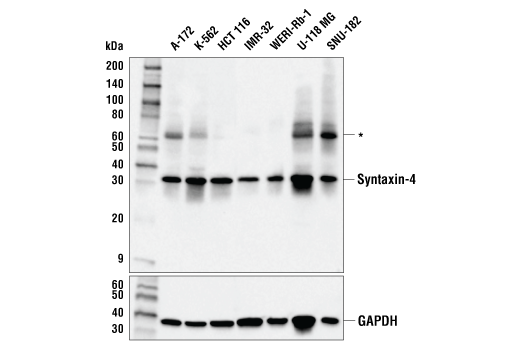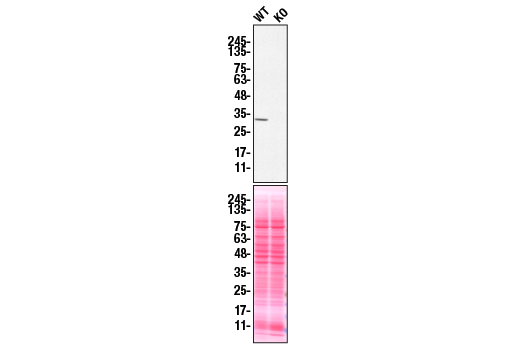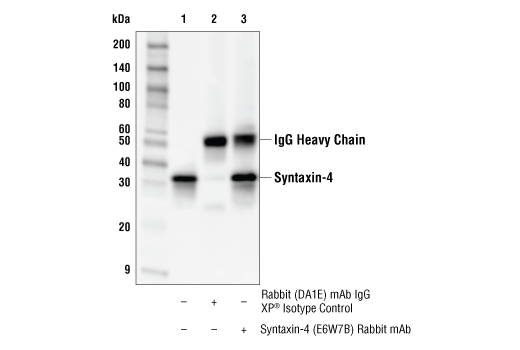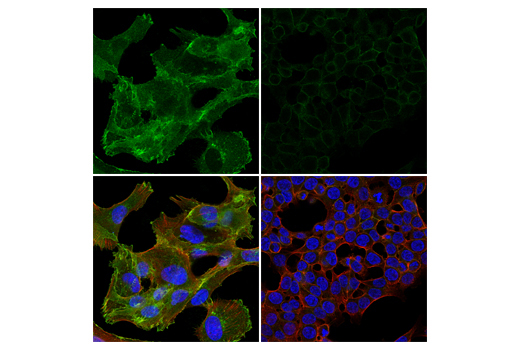WB, IP, IF-IC
H
Endogenous
35
Rabbit IgG
#Q12846
6810
Product Information
Product Usage Information
| Application | Dilution |
|---|---|
| Western Blotting | 1:1000 |
| Immunoprecipitation | 1:50 |
| Immunofluorescence (Immunocytochemistry) | 1:50 |
Storage
Specificity / Sensitivity
Species Reactivity:
Human
Source / Purification
Monoclonal antibody is produced by immunizing animals with recombinant protein specific to the amino terminus of human Syntaxin-4 protein.
Background
Proteins in the soluble N-ethylmaleimide-sensitive factor attachment protein receptor (SNARE) complex are integral membrane proteins involved in intracellular vesicle trafficking and exocytosis, and are essential for processes that require rapid, targeted, and regulated membrane fusion such as cell growth, hormone secretion, and neurotransmission (reviewed in 1,2). Functioning as a target or t-SNARE protein, Syntaxin-4 is characterized by a long cytoplasmic N-terminal region encompassing two coiled-coil domains, a single transmembrane domain, and a very short extracellular C-terminus (3). Syntaxin-4 is known to regulate glucose uptake in skeletal muscle and adipose tissue by facilitating the translocation of the glucose transporter GLUT4 from an intracellular compartment to the plasma membrane (4,5). Moreover, human islet β-cells overexpressing Stx4 exhibited enhanced insulin secretory capability, resilience against proinflammatory cytokine-induced apoptosis, and reduced chemokine expression (6). Additionally, research studies have indicated that Syntaxin-4 plays a role in the exocytosis of AMPA receptors in hippocampal neurons (7), lytic granule exocytosis in cytotoxic T-lymphocytes (8), and hepatitis C viral particle release (9).
- Jena, B.P. (2011) Adv Exp Med Biol 713, 13-32.
- Kasai, H. et al. (2012) Physiol Rev 92, 1915-64.
- Foster, L.J. and Klip, A. (2000) Am J Physiol Cell Physiol 279, C877-90.
- Olson, A.L. et al. (1997) Mol Cell Biol 17, 2425-35.
- Yang, C. et al. (2001) J Clin Invest 107, 1311-8.
- Oh, E. et al. (2018) Diabetes 67, 2626-39.
- Mohanasundaram, P. and Shanmugam, M.M. (2010) Sci Signal 3, jc7.
- Spessott, W.A. et al. (2017) Traffic 18, 442-52.
- Ren, H. et al. (2017) Eur J Cell Biol 96, 542-52.
Species Reactivity
Species reactivity is determined by testing in at least one approved application (e.g., western blot).
Western Blot Buffer
IMPORTANT: For western blots, incubate membrane with diluted primary antibody in 5% w/v BSA, 1X TBS, 0.1% Tween® 20 at 4°C with gentle shaking, overnight.
Applications Key
WB: Western Blotting IP: Immunoprecipitation IF-IC: Immunofluorescence (Immunocytochemistry)
Cross-Reactivity Key
H: human M: mouse R: rat Hm: hamster Mk: monkey Vir: virus Mi: mink C: chicken Dm: D. melanogaster X: Xenopus Z: zebrafish B: bovine Dg: dog Pg: pig Sc: S. cerevisiae Ce: C. elegans Hr: horse GP: Guinea Pig Rab: rabbit All: all species expected
Trademarks and Patents
Limited Uses
Except as otherwise expressly agreed in a writing signed by a legally authorized representative of CST, the following terms apply to Products provided by CST, its affiliates or its distributors. Any Customer's terms and conditions that are in addition to, or different from, those contained herein, unless separately accepted in writing by a legally authorized representative of CST, are rejected and are of no force or effect.
Products are labeled with For Research Use Only or a similar labeling statement and have not been approved, cleared, or licensed by the FDA or other regulatory foreign or domestic entity, for any purpose. Customer shall not use any Product for any diagnostic or therapeutic purpose, or otherwise in any manner that conflicts with its labeling statement. Products sold or licensed by CST are provided for Customer as the end-user and solely for research and development uses. Any use of Product for diagnostic, prophylactic or therapeutic purposes, or any purchase of Product for resale (alone or as a component) or other commercial purpose, requires a separate license from CST. Customer shall (a) not sell, license, loan, donate or otherwise transfer or make available any Product to any third party, whether alone or in combination with other materials, or use the Products to manufacture any commercial products, (b) not copy, modify, reverse engineer, decompile, disassemble or otherwise attempt to discover the underlying structure or technology of the Products, or use the Products for the purpose of developing any products or services that would compete with CST products or services, (c) not alter or remove from the Products any trademarks, trade names, logos, patent or copyright notices or markings, (d) use the Products solely in accordance with CST Product Terms of Sale and any applicable documentation, and (e) comply with any license, terms of service or similar agreement with respect to any third party products or services used by Customer in connection with the Products.



